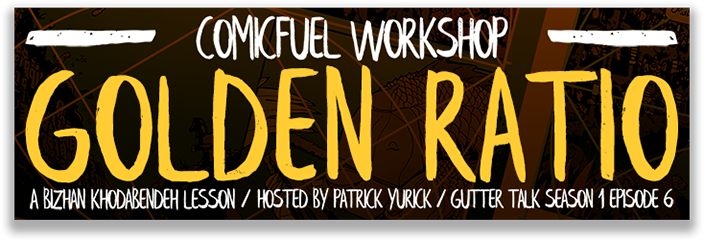The internet has transformed independent comics and given creators an easy way to get their stories out to the public. There are a lot of different ways to publish your work online, but two of the most popular are WordPress and WordPress running ComicPress. (more…)
Posts Tagged: How To
Panel Layout: The Golden Ratio
Announcing our FREE Golden Ratio Workshop designed to expand on the concepts introduced in the article below!

Excitement would understate how I felt when I read Frank Santoro’s articles on the first appearance of the Golden Ratio in Hergé’s TIntin comic pages. Santoro used grid overlays to explain comic composition with geometric shapes in a way that could be easily understood by a graphic designer, like myself. (more…)
Nondestructive Photoshop Shadows and Effects
Efficiency. As comic creators, we’re all striving for it. With full-time jobs, family, and everything else life throws at us competing for our precious art time, being more efficient means getting more done. My goal with these Photoshop articles is to help you streamline your process to get more work done in the same amount of time – or even less. I began with an article on using Photoshop Actions in your workflow. Today, I want to talk about using some of the more powerful features of a world class application like Photoshop. Specifically, creating shadows and effects nondestructively. But what is nondestructive editing? Let’s have Adobe explain it:
Nondestructive editing allows you to make changes to an image without overwriting the original image data, which remains available in case you want to revert to it. Because nondestructive editing doesn’t remove data from an image, the image quality doesn’t degrade when you make edits.
WRITING TROPES: EXPOSITORY DEVICES
Tropes are storytelling devices. Used well, they enrich a story; used badly, they result in the dreaded cliché. This series of articles takes a closer look at some major tropes relevant to comics and the pitfalls they may present.
Exposition
“Exposition is a literary tool that is used to give information to the audience through dialogue, description, flashback or narrative.” Source: tvtropes.org
How To Use Photoshop Actions To Speed Up Your Comic Work
If you use Adobe Photoshop at any point in your comics making process, then there’s a good chance you should be using Actions to speed up your process. But what are Actions, and why would you want to use them? (more…)
Easy Text Effects in Photoshop
This short video tutorial explains how to create quick, professional looking text sound effects using Photoshop. What’s more, the effect is non-destructive, meaning it uses layer styles on active text (not rasterized text) so you can change the word, change the look and even save it as a style to apply to other text. This is the way I do a majority of text effects on my comic Marooned.
Hand Lettering A Digital Comic, Part 3
Once you have your lines of text set out, it’s time to launch into the final stage of lettering a page: composing your text on the page, and this is where I think hand-lettering shows a great advantage over font or mechanical lettering: flexibility.
Dialogue That Writes Itself!
Dialogue can, in essence, make or break a comic. To graciously sidestep the pitfalls of comic speech, it’s a good idea to heed these pieces of advice:
Keep genre in mind
Where is your story set? How, realistically, would your characters interact with one another? Let’s say that you’re writing a period piece set in 1800s England. Quite obviously, you would like to avoid any anachronistic words such as “derp”, or “bro”, or “hashtag.” Unless, of course, your protagonist is a time traveler. (“Hashtags! Bloody hashtags everywhere, bro!”)
Anatomy Of A Storyboard Part 2: Continuity
Part one of this article discusses the ways in which storyboarding relates to comics as a visual, storytelling medium. Check it out for an explanation of storyboard frame dimensions, shot terminology, and camera movement.
Not everything about storyboarding translates perfectly to making comics. All movement is implied in comics. Although storyboards are technically just as static, film literally captures movement.
Actually, scratch that. Comic panels may not observably move, but in the mind’s eye, they do.
Think about it. Through the composition of the panel, the viewer is forced to move their eye in the direction the artist wants. This may or may not coincide with the implied path that the character will follow out of frame. The size, shape, and sequence of panels determines the pacing of the story for the reader. You can control movement, of a sort. (more…)
Anatomy Of A Storyboard Part 1: Terms & Techniques
Don’t look so confused.
Sure, an article about storyboarding may not be the first thing you’d expect on a site about making comics. Art, writing, marketing — these clearly apply to comics as they do many other creative pursuits. But storyboarding? That’s a movie-making technique.
While it’s true that storyboarding is an efficient process for visualizing a movie or television show prior to filming, storyboards actually share many similarities with comic books. They both tell stories through a sequence of drawings, using the same composition and framing techniques to help the audience follow along. Another shared attribute, one few people realize, is that each medium is transitory. Storyboards are meant to be tools that facilitate a film. They aren’t intended for public consumption, and exist only to serve the final form of the project. Comics are storytelling tools as well. No individual panel or drawing is meant to interfere with the story. The action exists in the imagination of the reader. (more…)









